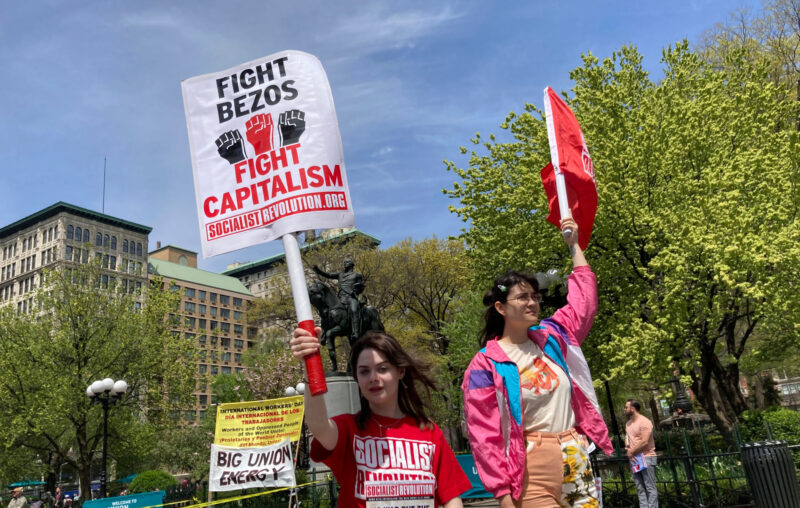


The National Labor Relations Act gives labor union officials powers that no other people in the private sector have. Here are the most important ones.
Because the National Labor Relations Act makes a certified union the exclusive bargaining agent for all workers in the bargaining unit, those who wanted the union and those who did not, the union can compel dues payments by all. (That’s not the case, however, in Right to Work states, where workers cannot be fired for non-payment of dues.) Unions can also prevent the company and workers from agreeing to their own contractual terms. And unions can bring legal action against companies for speaking forcefully against a unionization campaign, or for assisting unhappy workers in trying to oust a certified union.
For a thorough examination of the special treatment given to unions, see Professor Morgan O. Reynolds’ book Power and Privilege: Labor Unions in America.
What about violence and acts of deliberate property damage?
The law does not shield union officials from criminal liability for violence against individuals. They often get away with such violence (I include some terrible cases in my book Free Choice for Workers) but that’s due to the difficulty in prosecuting crimes they direct, not because the law allows it. Unfortunately, property damage by unions is another matter.
In 1946, Congress passed the Hobbs Act to make the law clear that coercive union racketeering tactics were illegal. But in 1973, the US Supreme Court badly weakened the law in United States v. Enmons, where it held that union-directed property destruction could not be prosecuted under the Hobbs Act by federal authorities, so long as the violence was done “in furtherance of legitimate union objectives.”
In that case, union officials in Louisiana had ordered attacks on property owned by Gulf States Utilities Company, including the firing of rifles at company transformers and draining the oil from a transformer to ruin it. In a 5–4 decision by Justice Potter Stewart, the Court said that Congress had not intended to criminalize property destruction when the purpose was to pressure the employer into giving in to union contract demands. That conclusion was too much for even so stalwart a leftist as Justice William O. Douglas, who wrote in dissent, “The Court today achieves by interpretation what those who were opposed to the Hobbs Act were unable to get Congress to do.”
So, federal prosecution of union property destruction is out, thanks to the Supreme Court’s tortured reading of the Hobbs Act. (Congress could rewrite the law to rectify that mistake, but it has never done so. A bill entitled the Freedom from Union Violence Act has been introduced many times since 1997 without any progress.)
What about the states? Can people who have suffered damage by unions sue in state courts?
That question brings us to a case that was recently argued before the Supreme Court, Glacier Northwest v. International Brotherhood of Teamsters Local 174. It raises the question whether state tort claims against union acts of destruction are barred by the NLRA.
The facts of the case are as follows. Glacier Northwest is a company that mixes and delivers concrete in the Seattle area. Early one morning, just as the company’s mixing trucks were about to head out to make their deliveries, the union called a work stoppage that left a large quantity of concrete hardening in the trucks’ drums. The loads had to be dumped, at considerable expense to the company. Damage to the equipment was narrowly averted. Glacier Northwest filed suit against the union in state court for its tortious conduct.
The union moved to have the case dismissed on the grounds that federal law preempts such suits. The trial judge granted that motion and that decision was upheld on appeal by the Supreme Court of Washington, grounding its ruling on a 1959 US Supreme Court case, San Diego Building Trades Council v. Garmon.
In typically fuzzy Warren-Court style, the majority held in that case that the NLRA has a “penumbral area” that bars state lawsuits against unions where they would clearly obstruct the law’s protection for collective bargaining. That “penumbral area” also extends, the Court held, to any conduct the law “arguably” protects. In Garmon, the suit was against a union’s picketing of a business where the employees had voted against unionization. According to the majority (it was 5-4), the NLRA “impliedly” blocks suits for damages caused by peaceful picketing against a business that the union has targeted.
Garmon is a very debatable case, but does it extend to suits against unions for non-peaceful, destruction conduct? That’s what the Supreme Court will decide in Glacier Northwest.
In an amicus brief submitted by the National Right to Work Legal Defense Foundation, the attorneys argue that the Supreme Court of Washington ruled in error. They write that it has “misread this Court’s preemption cases to conjure yet another special privilege for unions; an exemption from state tort law for intentional and wanton property destruction, if the destruction occurs in the context of a ‘labor dispute.’”
There have been other cases where lawsuits have been allowed in state courts against union destruction. One such case is Clegg v. Powers, (the report is not available online) a 1997 case that arose in Virginia where employees sued a union for violence and property damage they suffered. The union tried to have the case dismissed on Garmon preemption grounds, but the court rejected that argument, allowing the case to proceed. There is precedent for allowing suits against unions in state courts.
Assuming for the sake of argument that the NLRA’s objective of encouraging collective bargaining is lawful (a position I would argue against, since nothing in the Constitution authorizes Congress to interfere in labor relations, a purely local matter never meant to be covered by the power to “regulate interstate commerce”), giving unions a free pass for acts of destruction is not necessary to effectuate that objective. Unions can go about their legitimate objectives of trying to organize workers without committing acts of destruction.
If Glacier Northwest were to be decided in favor of the plaintiff, allowing the case to proceed, it would not prevent workers from forming unions, engaging in collective bargaining, nor going on strike. It would only signal to union officials that they have to respect the rights and property of others just as much as all Americans do.
The Court’s decision will probably be released in June. Let us hope that it subtracts from, rather than adds to, the power and privilege enjoyed by labor unions.
TELL YOUR FRIENDS ABOUT CITIZENS JOURNAL Please keep us publishing – DONATE




